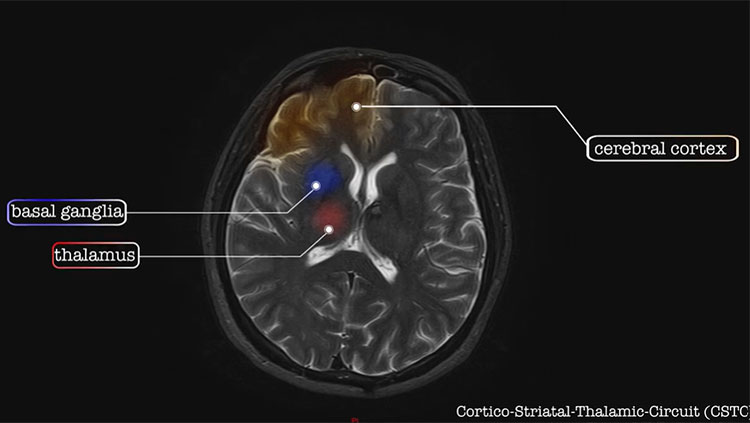The Watered Down Brain and Hydrocephalus
- Published26 Oct 2020
- Source BrainFacts/SfN
Inside the skull, the brain floats in a jelly-like substance called cerebrospinal fluid (CSF). CSF protects, nourishes, and cleans the brain. But the buildup of CSF puts pressure on the brain and can cause hydrocephalous, a condition with symptoms ranging from blurry vision to headaches and cognitive impairment.
This video is from the 2020 Brain Awareness Video Contest.
Created by Claris, Chloe, and Cleah Winston
CONTENT PROVIDED BY
BrainFacts/SfN
References
We use our brains every day as we travel, explore, meet people, eat, and just go about our daily business. But did you know that our brains are floating in a jelly-like fluid that is 99% water? Our brains really are, in a way, a watered-down brain, but what really is a fluid that our brains are floating in?
We’re talking about cerebrospinal fluid, or CSF for short, a thick fluid that lies between the brain and skull. It’s kind of like an egg — the yolk is like the brain, the white is the CSF, and the shell is the skull.
You may be asking, “what’s the point of watering down our brain with this CSF?” There are five main functions of CSF. First, it protects our brain by acting as a shock absorber to prevent damage to the brain itself. Second, it nourishes the brain because it is filled with blood-based nutrients. Third, it helps maintain homeostasis by regulating transport across the brain. Fourth, it helps clear the brain’s metabolic wastes that diffuses into the CSF and is removed into the bloodstream. Lastly, it allows for neutral buoyancy in order for the brain to maintain its density and shape, so it does not start looking like a, well, alien. It’s not positively buoyant, nor negatively buoyant, but it is neutrally buoyant, floating just in the middle.
Let’s talk a bit more about how the CSF provides nutrients to various parts of the brain. You’ve probably guessed that it’s not just staying in one place and being a couch potato. If it did the brain would soon have absorbed all the nutrients from the CSF and the CSF would not be able to provide any more nutrients to the brain.
Quite on the contrary, CSF is constantly being produced at a rate of about 0.4 milliliters per minute and is pushed through the space outside the brain. But what causes the CSF to circulate throughout the space?
Well, let’s start with anatomy. Our brains have these large cavities, or ventricles, deep under the surface of the brain that serve as sources for the CSF. Let’s take a closer look.
In these ventricles, tissues called choroid plexus extracts nutrients from the blood and secretes them into the ventricles to make CSF. The constant production of CSF and pumping up choroid plexus forces CSF to move through the ventricles all the way to the fourth ventricle. CSF then enters the subarachnoid space, which lies between the brain and the dura mater, and is pushed through this space, always passing right up above the tissue of the brain.
As CSF flows, the brain absorbs its nutrients. Eventually, all the nutrients are absorbed so the CSF is essentially of no use and is reabsorbed into the bloodstream. This happens at the top of the brain where CSF is pulled through these tunnels called arachnoid villi out of the subarachnoid space into the venous sinus. This system is known as the ventricular system.
That sounds great, but what if something goes wrong in the system?
In rare cases, problems in the ventricular system may result in hydrocephalus. What even is that?
Hydrocephalus is the buildup of CSF in the ventricles of the brain. Side effects include head enlargement in infants, blurry eyes, headaches, and cognitive difficulties. Sadly one out of every 770 babies develop hydrocephalus.
Hydrocephalus is either inherited at birth or acquired, so let’s talk about some of the specific causes of hydrocephalus. First, it is important to note that genetics can be a huge factor in development of hydrocephalus. Mutations in certain genes can result in problems in the ventricular system that result in hydrocephalus. So, what exactly could go wrong? As we discussed, CSF flow requires steady production of CSF by the choroid plexus, a clear path through the subarachnoid space, and reuptake by the venous sinuses.
Hydrocephalus results from lack of any of these. For example, arachnoid cysts and other obstructions that hinder circulation, lack of choroid plexus pumping and pulsing that hinder production and malfunctioning arachnoid villi that hinder reabsorption of CSF into the bloodstream could all hinder circulation and flow of CSF.
If flow decreases, CSF builds up resulting in hydrocephalus. Now let’s talk a bit about the symptoms. The buildup up of CSF puts immense pressure on the brain since CSF is pushing out at the brain. With all this pressure, you can probably imagine why headaches are a common symptom of hydrocephalus. But pressure also leads to brain damage. For example, the optic nerve that carries visual information from the eye to the brain is surrounded with subarachnoid space. CSF buildup puts pressure on this thereby damaging it and causing blurriness.
Hydrocephalus is an unfortunate condition, but all hope is not lost! There are multiple possible treatments of which the most common is shunt surgery. Here, a tube inserted into the brain reroutes excess CSF to the heart, lungs, or abdomen. Thankfully, numerous institutions such as the Hydrocephalus Association are hard at work promoting a cure for hydrocephalus and improving the lives of the brave fighters young and old affected by it.
Thank you for listening to “The Watered-down Brain and Hydrocephalus”!
Also In Childhood Disorders
Trending
Popular articles on BrainFacts.org

















